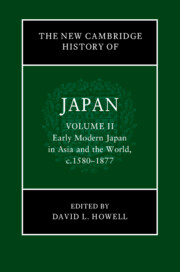Book contents
- The New Cambridge History of Japan
- The New Cambridge History of Japan
- The New Cambridge History of Japan
- Copyright page
- Contents
- Figures
- Maps
- Tables
- Contributors to Volume II
- Preface
- Frontispiece
- Introduction
- Part I The Character of the Early Modern State
- 1 The End of Civil War and the Formation of the Early Modern State in Japan
- 2 Politics and Political Thought in the Mature Early Modern State in Japan, 1650–1830
- 3 Regional Authority during the Tokugawa Period
- 4 Tokugawa Philosophy
- 5 Foreign Relations and Coastal Defense under the Mature Tokugawa Regime
- 6 The Meiji Restoration
- PART II Economy, Environment, and Technology
- Part III Social Practices and Cultures of Early Modern Japan
- Index
- References
2 - Politics and Political Thought in the Mature Early Modern State in Japan, 1650–1830
from Part I - The Character of the Early Modern State
Published online by Cambridge University Press: 15 January 2024
- The New Cambridge History of Japan
- The New Cambridge History of Japan
- The New Cambridge History of Japan
- Copyright page
- Contents
- Figures
- Maps
- Tables
- Contributors to Volume II
- Preface
- Frontispiece
- Introduction
- Part I The Character of the Early Modern State
- 1 The End of Civil War and the Formation of the Early Modern State in Japan
- 2 Politics and Political Thought in the Mature Early Modern State in Japan, 1650–1830
- 3 Regional Authority during the Tokugawa Period
- 4 Tokugawa Philosophy
- 5 Foreign Relations and Coastal Defense under the Mature Tokugawa Regime
- 6 The Meiji Restoration
- PART II Economy, Environment, and Technology
- Part III Social Practices and Cultures of Early Modern Japan
- Index
- References
Summary
Rising literacy, urbanization, and leisure time in early modern Japan led to increasing popular interaction with politics. This chapter, after confirming the basic political apparatus of the Tokugawa state, demonstrates how the governance carried out within that apparatus interacted with increasingly vibrant expressions of political opinion from outside the state. From erudite Confucian analysis to popular riot and lewd graffiti, this chapter argues that public political opinion and action both influenced and at times was courted by the shogunal government. Political discussions in salon and popular culture outside the state introduced key new political ideas which transformed the ideal of governance in Japan from a minimalist concept of military domination and agricultural facilitation to a much more comprehensive vision of general welfare and development.
Keywords
- Type
- Chapter
- Information
- The New Cambridge History of Japan , pp. 58 - 96Publisher: Cambridge University PressPrint publication year: 2023



